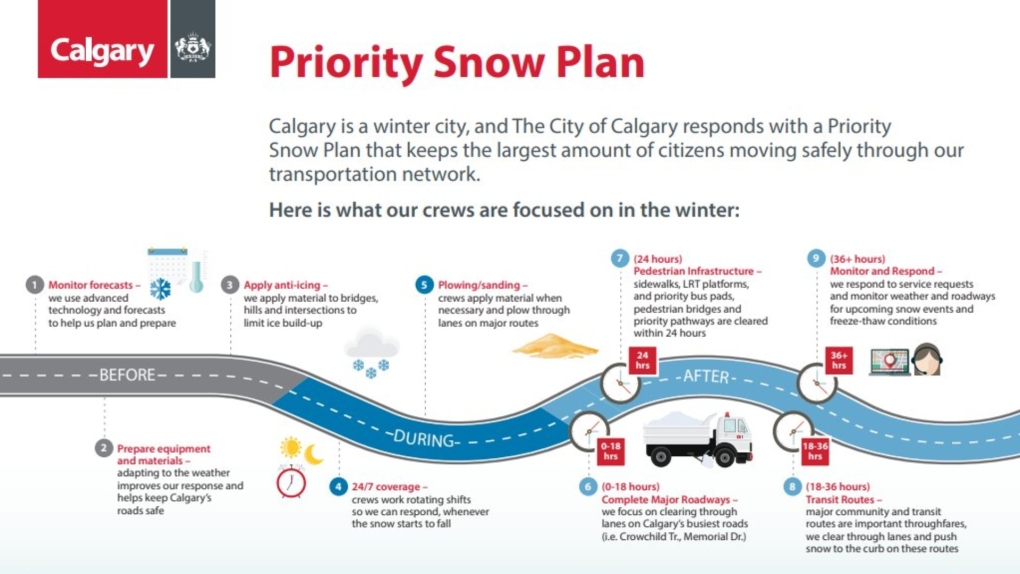Calgary drivers face slick and slow commutes amid snowfall
 A stock photo of a snowy Calgary roady. (Pexels/Michael Job Loquellano)
A stock photo of a snowy Calgary roady. (Pexels/Michael Job Loquellano)
Calgarians saw slippery driving conditions on their commutes to and from work on Friday.
Police say almost 60 collisions were reported between midnight and 11:30 a.m., including three with injuries and three hit-and-runs.
With flurries expected to continue this weekend, Calgary road crews are applying salt to streets to prevent a buildup of ice.
"Particularly when those temperatures dip after the sun has gone down and before it comes up, that's where the challenges with ice can present themselves," said Chris McGeachy, city mobility spokesperson.
"Leave plenty of time to get to where you need to go and leave plenty of space between your vehicle and the vehicle in front."
McGeachy says the city has crews working 24-7 in the winter months, but has also called for reinforcements.
"Because of the significant accumulation of snow through Thursday and Friday, and expected into Saturday, we have extra contracted crews called in."
How Calgary handles snow-covered roads
Calgary clears snow-covered roads using a Priority Snow Plan.
Crews spend the first 18 hours after snow stops falling tackling Priority 1 routes, including roads with more than 20,000 vehicles per day, like Crowchild Trail, as well as downtown cycle tracks. (Deerfoot Trail and Stoney Trail are maintained by the provincial government.)
Crews then focus on Priority 2 routes — roads that carry more than 5,000 vehicles a day — like Kensington Road and Acadia Drive, as well as designated emergency routes around hospitals and fire stations, bus routes and roads with on-street bike lanes. This is done from 18 hours after snowfall ends to 36 hours.
After that, crews turn to clearing Priority 3 routes, which include school and playground zones.
Though the city does not typically clear snow from residential streets, crews will level ruts in them as needed.

Ring road and Deerfoot Trail
In Calgary, both Deerfoot Trail and Stoney Trail are maintained by the provincial government.
In a statement to CTV News on Friday, the press secretary for the minister of transportation's office said contractors work 24-7 every day of the year to ensure roadways are as safe as possible.
"For the ring roads and Deerfoot, the expectation is that the trucks be able to operate around the clock during the snowfall, and during the subsequent clean up following the end of the snowfall.
"Drivers are reminded to give snowplows lots of room to work. In return, they will pull over to let you pass every five to eight kilometres or when it is safe to do so."
Snow-route parking bans
The City of Calgary can declare a snow-route parking ban to help road crews clear streets from snow.
The parking bans are put in place when Calgary has seen a significant accumulation of snow.
Once called, snow-route parking bans can be in place for up to 72 hours.
Snow routes are indicated by blue signs with a white snowflake symbol.
Any vehicles left on snow routes during the ban can be ticketed or towed, but on-street accessible parking is exempt.
For more information on our winter maintenance operations and updates, visit calgary.ca/snow.
CTVNews.ca Top Stories

Celine Dion delivers stirring comeback performance at Paris Olympics opening ceremony
Against the rainy Paris night sky, Celine Dion staged the comeback of her career with a powerful performance from the Eiffel Tower to open the Olympic Games.
Jasper wildfire: 'Several weeks' before residents can return, premier says
Premier Danielle Smith said Friday afternoon in Hinton while weather conditions are cooler, the Jasper fire is still considered out of control and that Jasper residents can expect to be away from their homes 'for several weeks.'
Missing 3-year-old boy found dead in creek in Mississauga, Ont.: police
A three-year-old boy has been found dead a day after he went missing in a park in Mississauga, Ont., Peel police say.
Irish museum pulls Sinead O'Connor waxwork after just one day due to backlash
An Irish museum will withdraw a waxwork of singer-songwriter Sinéad O'Connor just one day after installing it, following a backlash from her family and the public, it told CNN in a statement on Friday.
Winnipeg senior's account overdrawn for $146,000 water bill
A Winnipeg senior is getting soaked with a six-figure water bill.
FBI says Trump was indeed struck by bullet during assassination attempt
Nearly two weeks after Donald Trump’s near assassination, the FBI confirmed Friday that it was indeed a bullet that struck the former president’s ear, moving to clear up conflicting accounts about what caused the former U.S. president’s injuries after a gunman opened fire at a Pennsylvania rally.
Driver charged after flashing high beams at approaching police
Orillia OPP arrested and charged a driver with impaired driving after flashing their high beams.
Turpel-Lafond won't sue CBC over Cree heritage report that took 'heavy toll': lawyer
The lawyer for a former judge whose claims to be Cree were questioned in a CBC investigation says his client is not considering legal action against the broadcaster after the Law Society of British Columbia this week backed her claims of Indigenous heritage.
Major Canadian bank experiences direct deposit outage on payday
Scotiabank says it has fixed a technical issue that impacted direct deposits on Friday morning.
































